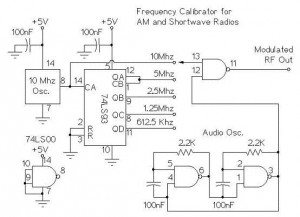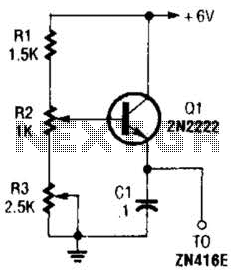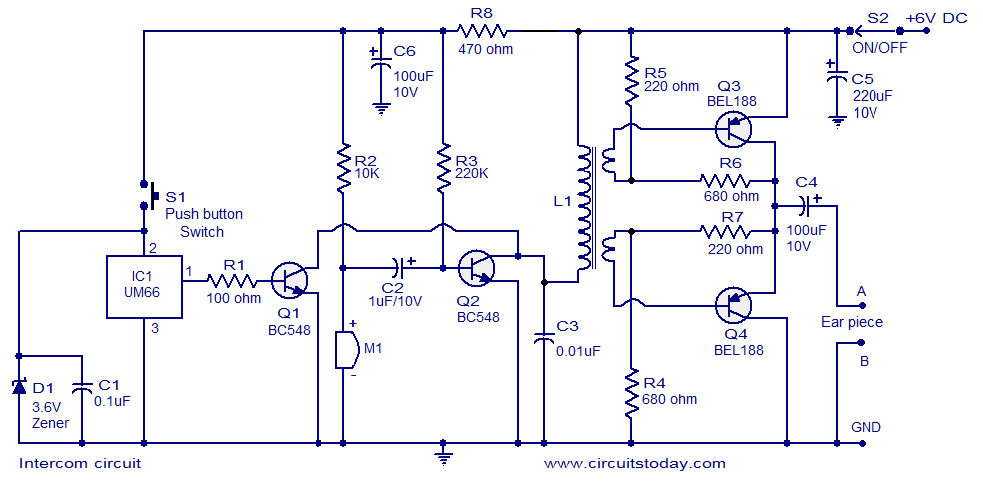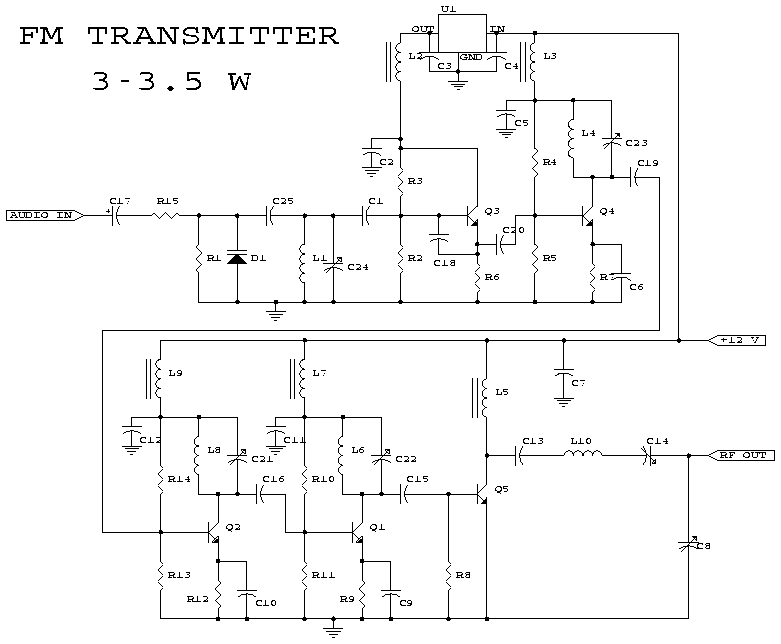
Variable corner frequency tone circuit
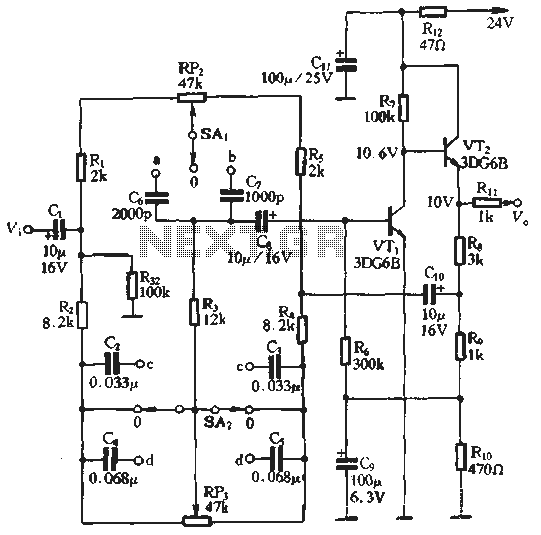
An attenuation switch is utilized to modify the pitch of a feedback control circuit's transition frequency, specifically for two treble controls. RP3 is designated for bass control, while SA1 and SA2 are employed to adjust the high bass control corner frequency rate. In this circuit, VTi functions as a common-emitter amplifier, and VT2 serves as an emitter input. The output signal is phase-aligned with the input signal due to the amplifier's configuration. This design fulfills the phase requirements of the feedback tone control circuit and features low output impedance. The high input impedance of VT2 allows for the selection of a higher collector load resistor (100kΩ), resulting in a two-stage amplifier with high voltage gain. The tone control circuit achieves balance through the voltage divider formed by resistors R and Rio, which feeds back to the tone signal voltage divider circuit. Consequently, the tone control circuit can provide approximately three times the intermediate frequency voltage gain for high and low frequencies, adjustable via SA1. Different capacitors can also be selected to fine-tune the control frequency. When SA1 is set to position d, the treble control operates at a frequency of 2.5 kHz; when set to position b, it adjusts to 5 kHz. For SA2, when set to position c, the bass control frequency is 500 Hz, and when set to position d, it adjusts to 250 Hz.
The described circuit serves as an advanced tone control system, integrating multiple components to achieve precise audio frequency adjustments. The attenuation switch plays a critical role in modifying the feedback control circuit's transition frequency, allowing for tailored audio output. The use of VTi as a common-emitter amplifier ensures that the circuit maintains a high voltage gain while preserving the phase relationship between input and output signals. The configuration of VT2 as an emitter follower enhances the circuit's input impedance, thus enabling the use of a high-value load resistor without compromising the performance of the amplifier stages.
The feedback mechanism is essential for maintaining audio fidelity and ensuring that the tone adjustments do not introduce distortion. The circuit's design incorporates resistors R and Rio to create a voltage divider that stabilizes the signal, allowing for effective feedback to the tone control circuit. This configuration enables a significant amplification of the intermediate frequency signals, enhancing the circuit's ability to manage both high and low frequencies effectively.
The selection of capacitors in conjunction with the switch positions SA1 and SA2 provides further customization of the audio output. By adjusting the capacitors, users can fine-tune the treble and bass frequencies to suit their preferences or specific audio environments. This flexibility is particularly beneficial in professional audio applications where precise sound control is paramount.
Overall, the circuit exemplifies a sophisticated approach to audio signal processing, combining feedback control, amplification, and frequency adjustment to deliver a versatile tone control solution.By selecting an attenuation switch to change the pitch of a feedback control circuit transition frequency real cases. Hu) for 2 treble controls, RP3 for bass control, SA1, SA2 are used to change the high bass control corner frequency rate. In the circuit, VTi as common-emitter amplifier, VT2 as emitter input m, the output signal with the input signal phase amplifier instead. This will not only meet the feedback tone control circuit phase requirements, and the circuit has a low output impedance.
Due to high input impedance VT2, VTi collector load resistor may be selected from a higher resistance (lOOkf7,), so that the two-stage amplifier with high voltage gain, tone control circuit which is great the balance of the circuit by dividing voltage circuit R &, and Rio will be fed back to the tone signal voltage divider circuit, so that the tone control circuit made of about three times the intermediate frequency electric voltage gain o tone control of high and low frequency from the control frequency, by SAi, Feng also choose a different capacitor to adjust. When SAi when placed d, treble control from the control frequency of 2.5kHz; when b is placed becomes 5kHzoSA2 placed c, bass controlled from the control frequency is 500Hz; when d is placed into 250 .
The described circuit serves as an advanced tone control system, integrating multiple components to achieve precise audio frequency adjustments. The attenuation switch plays a critical role in modifying the feedback control circuit's transition frequency, allowing for tailored audio output. The use of VTi as a common-emitter amplifier ensures that the circuit maintains a high voltage gain while preserving the phase relationship between input and output signals. The configuration of VT2 as an emitter follower enhances the circuit's input impedance, thus enabling the use of a high-value load resistor without compromising the performance of the amplifier stages.
The feedback mechanism is essential for maintaining audio fidelity and ensuring that the tone adjustments do not introduce distortion. The circuit's design incorporates resistors R and Rio to create a voltage divider that stabilizes the signal, allowing for effective feedback to the tone control circuit. This configuration enables a significant amplification of the intermediate frequency signals, enhancing the circuit's ability to manage both high and low frequencies effectively.
The selection of capacitors in conjunction with the switch positions SA1 and SA2 provides further customization of the audio output. By adjusting the capacitors, users can fine-tune the treble and bass frequencies to suit their preferences or specific audio environments. This flexibility is particularly beneficial in professional audio applications where precise sound control is paramount.
Overall, the circuit exemplifies a sophisticated approach to audio signal processing, combining feedback control, amplification, and frequency adjustment to deliver a versatile tone control solution.By selecting an attenuation switch to change the pitch of a feedback control circuit transition frequency real cases. Hu) for 2 treble controls, RP3 for bass control, SA1, SA2 are used to change the high bass control corner frequency rate. In the circuit, VTi as common-emitter amplifier, VT2 as emitter input m, the output signal with the input signal phase amplifier instead. This will not only meet the feedback tone control circuit phase requirements, and the circuit has a low output impedance.
Due to high input impedance VT2, VTi collector load resistor may be selected from a higher resistance (lOOkf7,), so that the two-stage amplifier with high voltage gain, tone control circuit which is great the balance of the circuit by dividing voltage circuit R &, and Rio will be fed back to the tone signal voltage divider circuit, so that the tone control circuit made of about three times the intermediate frequency electric voltage gain o tone control of high and low frequency from the control frequency, by SAi, Feng also choose a different capacitor to adjust. When SAi when placed d, treble control from the control frequency of 2.5kHz; when b is placed becomes 5kHzoSA2 placed c, bass controlled from the control frequency is 500Hz; when d is placed into 250 .
